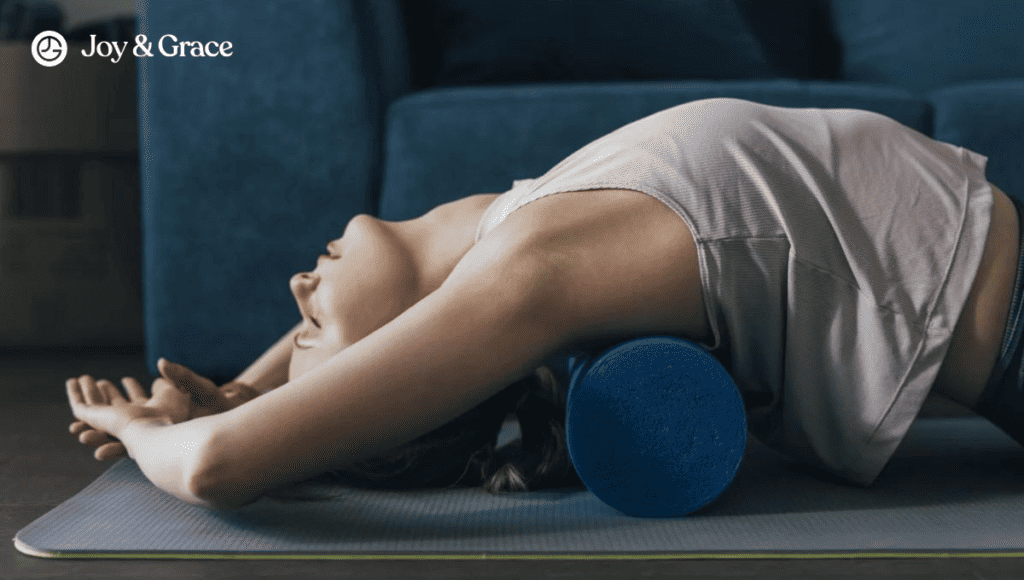Neck pain is a universal struggle, and the path to relief is often paved with uncertainty. In your search for relief, you may have come across foam rollers.
Foam rolling is a form of self-myofascial release that involves using a foam roller (duh, right?) to apply pressure to specific points on your body. Essentially, you use your own body weight to generate the pressure. But you ask, “Can foam rollers truly give me relief?”
Picture this: conflicting opinions and scientific studies. If you've ever found yourself caught between the promises and pitfalls of foam rolling, you're not alone. Let’s explore the science behind foam rolling together.
Do Foam Rollers Work For Neck Pain?
There seems to be conflicting information on this matter.
Some say that foam rolling can work wonders if you have neck pain, while others believe that foam rolling the neck should be avoided. First, let’s look at the evidence supporting the use of foam rollers for neck pain.
- In a study from 2020, patients with mechanical neck pain were divided into two groups.
One group received 10 minutes of heat therapy and 10 minutes of stretching. Meanwhile, the other group received the same treatment along with 5 minutes of foam rolling. The results showed that the group with the foam roller treatment had greater short-term improvement in neck pain and range of motion
- In another study, 24 patients with forward head posture were divided into two groups.
One group received a non-vibrating foam roller, while the other received a vibrating foam roller. After treatment, there was reduced neck pain and stiffness of the upper trapezius in the second group.
Remember self-myofascial release? Self-myofascial release (SMR) is a technique that you can use to release tension and tightness in the fascia. The fascia is a connective tissue that surrounds muscles, nerves, and organs, providing support and structure to the body.
However, the fascia can become tight and restrict movement due to factors like:
- Exercise
- Repetitive movements
- Injury
This also results in painful points in the muscle called trigger points. These symptoms are characteristic of a condition called myofascial pain syndrome. This condition is a common cause of chronic neck and shoulder pain.
In another study from 2020, individuals suffering from chronic neck pain were asked to perform self-myofascial release with foam rollers and roller balls. This treatment lasted for four consecutive weeks. After treatment, the intensity of the pain and the presence of active trigger points were reduced.
What Are The Benefits Of Foam Rolling My Neck?
Foam rolling has rapidly gained recognition in the sports and wellness communities. This popularity is due to its supposed numerous benefits. When applied to your neck, foam rolling can provide a kind of self-massage, working on the muscle tension that causes stiffness and pain.
Aside from their effects on pain and mobility, foam rollers are also thought to relieve stress, which is a common contributor to pain. The neck is a common area where stress manifests physically as knots or tension. According to a study, 30 minutes of foam rolling significantly reduced the levels of the stress hormone cortisol in the blood.
Besides stress relief and improved mobility, foam rolling is also thought to reduce delayed-onset muscle soreness (DOMS). It may also speed up recovery time. DOMS is the pain and stiffness you feel 24 to 72 hours after intense physical activity. This is common if you've engaged in new or strenuous exercises. According to a study, foam rolling can also delay the start of muscle fatigue and enhance your strength and performance.
But take note: none of these studies were done on the neck or shoulders.
Does Foam Rolling Help Joint Pain?
There are no studies available on the effects of foam rolling on joint pain. However, foam rollers may indirectly help with joint pain by improving joint mobility.
It’s common for reduced joint mobility to come along with joint pain. In a review, foam rollers improved the range of motion in various joints, namely the knees, hips, and ankles.
Although there was no mention of its effects on the shoulder joint, the same rules should also apply to these areas.
Does Foam Rolling Release Tension?
Releasing tension is actually one of the main selling points of foam rollers.
In fact, athletes often report reduced muscle tension and improved range of motion. This is supported by a review that states that foam rolling can help reduce muscle stiffness and improve your range of motion when combined with stretching and warm-up exercises.
Does Foam Rolling Help Nerves?
No studies are available on the benefits of foam rollers for neck and shoulder pain from nerve damage or neuropathic pain.
However, we did find a study involving patients with diabetic neuropathy. In the study, foam rolling along with massage improved pain, sensation, and blood circulation in neuropathic (nerve-damaged) areas. This allowed the patients to perform aerobic and resistance exercises better.
Still, we can’t really come up with a conclusion from a single study.
In fact, it may be better to avoid foam rolling if you’re dealing with pain from nerve damage or irritation. The inconsistent pressure from foam rolling may press on the nerves and worsen your symptoms.
Is A Foam Roller Good For Shoulder Pain?
Based on the available studies, foam rollers show promise for relieving shoulder pain. However, further studies are required to confirm these effects, as current research on this topic is limited.
To describe some examples:
- In one study, swimmers underwent an 8-week program that included foam rolling. After the program, there was a decrease in shoulder pain and an improvement in forward head posture and round shoulders.
However, we can’t really conclude that foam rolling was responsible for this effect, as the program used in the study also included shoulder-strengthening exercises. The same results were seen in a 2021 study involving office workers.
- As mentioned above, foam rolling is a form of self-myofascial release.
A study looked into the effects of self-myofascial release on teenage tennis players. Results show that self-myofascial release on the chest muscles and a muscle on the shoulder blade (infraspinatus) improved the range of motion in the shoulder. However, the study used a tennis ball instead of a foam roller.
Can I Foam Roll If I Have A Rotator Cuff Injury?
Things might be a bit different if you’re dealing with a rotator cuff injury. Pain from an injury like a rotator cuff tear might lead you to consider foam rolling for shoulder pain. No studies or guidelines on using foam rollers for rotator cuff injuries are available, so it may be a good idea to avoid them for now.
We found only one study on the potential of foam rolling for rotator cuff injuries. In this study, foam roller stretches on the upper back (thoracic spine) improved shoulder function in patients with shoulder impingement syndrome.
Shoulder impingement syndrome occurs when the rotator cuff muscles become compressed or irritated. This happens as they pass through the narrow space between the upper arm bone (humerus) and the acromion (a bony prominence on the shoulder blade). It can also affect the nerves or blood vessels of your shoulder.
All in all, it’s probably best to avoid foam rolling, at least until the injury has healed. Foam rolling may not be suitable in the early stages of a rotator cuff injury. Instead of easing your symptoms, the pressure the foam roller applies to an already inflamed area might make them worse.
In such circumstances, physical therapy is often recommended over foam rolling. You should only consider foam rolling after fully recovering. You should also wait for the green light from your physical therapist or healthcare provider.
Is Foam Roller Good For Frozen Shoulder?
Like rotator cuff injuries, no guidelines or studies are available on foam rollers for frozen shoulder syndrome.
Frozen shoulder, or adhesive capsulitis, is a condition that causes pain and stiffness in your shoulder joint. This happens when the capsule surrounding the joint thickens and tightens. It’s like an adhesion in your shoulder (hence the name).
So, foam rolling may possibly help with a frozen shoulder, as one of its supposed benefits is the breakdown of adhesions. However, it’s best to avoid it for now and wait for studies to come out.
Is It Safe To Use A Foam Roller On Neck?
This is where the confusion comes in. Some professionals do not recommend foam rolling directly over the neck, as it’s quite a delicate and sensitive structure. The neck houses important structures such as nerves and blood vessels. The pressure from foam rolling may compress these structures, leading to devastating consequences.
For example, foam rolling directly over the neck can potentially compress the nerves. This can lead to pain, tingling, or other neurological symptoms.
The neck also houses blood vessels that supply blood to the brain, called carotid arteries. Excessive pressure on these vessels can obstruct blood flow to the brain and could have serious consequences.
So, should you avoid foam rolling your neck altogether? Well, we suggest consulting your healthcare provider to get a proper evaluation of the cause of your pain. We also suggest seeking guidance from a healthcare professional, such as a physical therapist, on the proper use of a foam roller.
Instead of directly rolling over the neck, some professionals recommend focusing on surrounding areas, such as the upper back, shoulders, and trapezius. You can also try a massage ball, a tennis ball, or even just your hands to massage the neck softly.
Where Should I Not Use A Foam Roller?
Some professionals say the neck isn’t the only area you should avoid foam rolling over. Foam rolling is usually reserved for areas with dense, large muscles. These include the chest, upper back, thighs, and glutes. Foam rolling should be avoided in the following areas:
- Bony prominences or areas such as the knees, elbows, or shins
- Lower back
- Abdomen
- Areas with inflammation or injuries
You should also avoid foam rolling if you have any of the following conditions:
- Open wounds
- Burns
- Deep vein thrombosis (a blood clot usually in the veins of the legs)
- Osteomyelitis (a bone infection)
- Use blood thinners
Is It Bad To Foam Roll A Strained Muscle?
Muscle strain, or a pulled muscle, is a common cause of neck and shoulder pain. A strained muscle usually means that the muscle fibers have been torn to some extent, leading to inflammation and pain. We wouldn’t consider foam rolling a strained muscle bad, but it depends on the severity of the strain.
Muscle strains can be graded into:
- Grade I (Mild) – Grade I strains are considered mild and involve minimal damage to muscle fibers. They only cause mild pain, swelling, and inflammation. You might also have a mild loss of strength and flexibility. Grade I strains usually resolve within a few days to a couple of weeks with rest, ice, compression, and elevation (RICE).
- Grade II (Moderate) – Grade II strains involve a more significant injury with a partial tear of muscle fibers. The pain from grade II strains is moderate to severe, with noticeable swelling and bruising. You’ll also have a noticeable loss of strength and flexibility. These strains can take several weeks to a few months. You may need medical attention and physical rehabilitation.
- Grade III (Severe) – Grade III strains are the most severe and involve a complete tear or rupture of the muscle. You’ll have intense pain immediately after the injury. You will also have significant swelling, bruising, and muscle deformity. You’ll also completely lose your strength and won’t be able to use the muscle. A grade III strain may require surgery, and recovery can take several months. Rehabilitation is crucial to regain strength, flexibility, and function.
So, should you foam roll over a pulled muscle? Well, it’s best to consult with a physical therapist or your healthcare provider. However, it’s recommended to avoid foam rolling a grade I strain during the first 24–48 hours. You might need to wait a week or more for grade II strains. Foam rolling isn’t recommended for grade III strains until you start physical therapy.
How Do I Use A Foam Roller For Neck And Shoulder Pain?
Before using a foam roller for neck and shoulder pain, it's essential to know how to use it correctly to prevent further injury. The problem is that there isn’t a clear guideline or consensus on the proper foam rolling technique. Furthermore, it’s challenging to maintain consistent pressure when foam rolling. This can either make it ineffective or put you at risk for injury.
Still, here are the steps you can take:
- Choose the Right Roller
The right roller can make a huge difference in relieving neck and shoulder pain without causing further injury. We’ll elaborate more on this later.
- Warm-up First
Perform gentle neck and shoulder stretches before using the foam roller to warm up the muscles and increase blood flow.
- Start Slowly
Begin with gentle movements and light pressure. If you're new to foam rolling or have significant tension, it's important not to cause additional strain or discomfort.
- Use Gentle Pressure
Apply gentle and controlled pressure, especially when rolling over sensitive areas. You can always increase the pressure gradually as you get used to the technique.
- Avoid the Spine
As mentioned earlier, it’s best not to roll directly over the spine. Instead, focus on the muscles on either side of the spine.
- Controlled Movements
Move slowly and with control. Avoid rapid or jerky movements to prevent injury.
- Breathe
Remember to breathe deeply and consistently. Deep breathing can help your muscles relax and may enhance your experience.
- Modify Positions
Experiment with different positions to target various muscle groups. For example, you can roll while sitting, lying on the floor, or even against a wall.
- Short Sessions
Keep your foam rolling sessions relatively short, especially in the beginning. You can gradually increase your duration as your body adjusts.
- Listen to Your Body
Pay attention to how your body responds. If you experience discomfort, it’s best to stop foam rolling.
How Do I Use A Foam Roller For Neck Tension?
Again, we don’t recommend using foam rolling to relieve pain from underlying conditions. Consult a healthcare professional before performing the techniques we’ll mention below.
If your doctor gives you the green light, here are some foam rolling techniques that are commonly thought to help relieve neck tension:
- To start, use a foam roller pressed against a wall or door.
- Make sure the foam roller supports the natural curve of your neck, beginning at the base of your skull.
- Press against the door, using your legs for support.
- Do a chin tuck and slowly roll your neck over the foam roller, applying light pressure with your legs.
- Repeat this motion 10–15 times.
- Turn your head to one side, such as the left.
- Slowly roll your neck, focusing on the side you turned toward.
- Repeat on the opposite side.
- Stand tall and do a chin tuck.
- Turn your head to one side as far as you can, feeling a deep stretch.
- Hold for 10 seconds.
- Gently press into the stretch with your hand to go deeper.
- Do both sides, 3-5 reps each.
- Look over your shoulder, rotating your head.
- Place one hand on top of your head and gently pull down toward your armpit.
- Hold for 10–15 seconds.
- Repeat 3-5 times per side.
- Bend the arm on the side you want to target.
- Reach that hand across your lower back.
- Turn your head away from the side you're stretching.
- Use your other hand to gently tilt your head toward your shoulder, feeling a deep stretch.
- Hold for 10–15 seconds.
- Repeat 3-5 times per side.
Remember to breathe deeply throughout these exercises. If you come across a particularly tender spot, spend some extra time there, but don't push it too hard. Foam rolling should be healing, not painful.
How Do I Use A Foam Roller For Shoulder Pain?
We’ll repeat it here just to get the point across: do not attempt foam rolling if you’re dealing with a shoulder condition such as a rotator cuff injury. Consult a healthcare professional before performing any of these exercises.
- Shoulder Pop and Roll
- Kneel on the floor and place a foam roller in front of your body.
- Lean forward and put your hands on the foam roller while pressing down into the floor for stability.
- Look down towards your chest and slowly roll your upper body backward to feel a stretch in your shoulders and arms.
- Shift your hands to the outer edges of the foam roller and roll forward again to increase the stretch.
- Hold this deep stretch for 15-20 seconds. Repeat for 3–5 sets.
- Position the foam roller at an angle in front of you.
- Lean your body slightly away from the angled foam roller.
- Slowly roll your upper body forward, focusing on feeling a deeper stretch in the shoulder on the opposite side of the angled foam roller.
- Repeat on the other side, angling the foam roller to focus the stretch on the other shoulder.
- Place a foam roller vertically next to a wall.
- Bend one elbow and rest your arm on the foam roller while pressing into it for stability.
- Put your free hand on your hip and look to the side of your stretched arm.
- Keep your arm in a straight line from shoulder to elbow, and press your elbow into the foam roller to feel a deep stretch.
- Hold for 15-20 seconds. Repeat for 3–5 sets.
- For an extra shoulder stretch, gently perform a slight "chicken wing" motion with your elbow.
- Lie on your side and place a foam roller under your upper body.
- Support yourself with your lower body and bend the top leg for stability.
- Slowly roll your upper body up and down over the foam roller to massage your lat muscles.
- Gently tilt your body forward and back to target different areas of the muscles.
- Lie face down with the edge of a foam roller under one side of your chest.
- Slowly slide your hand on the floor forward and back to move your body over the roller.
- Use your other hand to press the roller into your upper chest area and vary the intensity.
- Make sure the roller targets the top portion of your chest as you roll.
How Long Should I Foam Roll?
In one study, the participants foam-rolled for 20 minutes immediately after their workout. They also repeated this 24 and 48 hours after exercising. However, shorter sessions may be all you need.
Research shows that just 90 seconds of rolling may be enough to reduce pain. One study found that applying steady pressure with a foam roller for 90 seconds on trigger points reduced pain sensitivity in those areas.
Foam rolling for too long could potentially cause bruising or further irritate the fascia.
Is It Okay To Use A Foam Roller Everyday?
Using a foam roller every day might be okay for some people. Emphasis on some. As mentioned earlier, foam rolling may relieve muscle soreness after a challenging workout. It shouldn't be used to address chronic or ongoing pain from an underlying condition, except for myofascial pain syndrome.
That said, you should still be careful when using foam rollers to deal with post-workout aches. If you’re foam rolling with moderate pressure and for a reasonable amount of time, it's generally safe to do it daily. But if you’re digging in too aggressively or spending too much time on a particular area, you might be putting yourself at risk for injury.
If you're new to foam rolling, it might be wise to start rolling for shorter durations and gradually increase your time as your body gets used to it. Remember, the goal is to relieve pain, not create it.
Which Foam Roller Is Best For Neck Pain?
Choosing the right foam roller can be quite a balancing act. You want something soft enough to massage your muscles without causing trauma. But while a super-soft roller might feel nice, it won't really work out those muscle knots. On the flip side, an ultra-firm roller might make you yell, “Ouch!” So, choosing the right foam roller is an important step in finding relief.
A softer foam roller may be best if you’re dealing with neck pain. Remember, the neck is a delicate structure. A softer, more-giving foam can be kinder to the neck muscles and keep the bones, blood vessels, and nerves of the neck safe. Soft foam rollers provide gentle yet effective pressure to help relax tense muscles. This makes them ideal if you’re a newcomer to foam rolling. Soft rollers might also adjust to the curve of your neck, preventing more pain.
You might also want to consider textured foam rollers. These foam rollers are firm, with spikes or knobs arranged in a grid-like manner. They can reach deeper into the muscle and provide a more intense massage. Just remember to be gentle when applying pressure.
Shoulder pain, on the other hand, might require a different level of firmness as you’ll be targeting larger muscles. This includes muscles like the trapezius, lats, chest, and arm muscles. A medium-to-firm foam roller may be more beneficial in this case. These denser foam rollers can take on more body weight without losing shape, generating more pressure on the larger muscles.
Density and texture are not the only factors to consider when choosing a foam roller. The size of the roller plays a significant role, too.
What Size Of Foam Roller Should I Get?
The size of the foam roller depends mainly on the area you want to target. A shorter foam roller (about 12 to 18 inches) is typically a good pick, allowing you to target the neck and shoulder muscles accurately.
But if you want to target larger or multiple areas, you might want to consider a longer foam roller. Typically, the longest length for a foam roller is around 36 inches. This allows you to target larger muscles, such as the trapezius, which also helps with neck, shoulder, and back pain.
On the other hand, smaller rollers (around 4 to 12 inches) can be a great ultra-portable option that you can easily tote around. This makes them perfect for combating pain during a holiday vacation.
Your comfort should be your top priority when shopping for a foam roller. If you find that foam rolling causes more pain than relieving it, try out a foam roller of a different size or density.
Takeaway
In our exploration of foam rollers for neck and shoulder pain, we found they can be helpful. But we should tread carefully and observe caution. Studies show short-term relief for neck muscle pain and stress reduction, but it's not a one-size-fits-all solution.
Furthermore, there seems to be a lack of clear guidelines and a great deal of conflicting information.
Foam rolling can improve mobility and reduce muscle soreness, but there's limited evidence for joint pain and nerves. Consult a healthcare professional when it comes to specific issues like rotator cuff injuries or frozen shoulders. Wait for their green light before experimenting with foam rolling.
Remember, safety comes first! Start slow and apply gentle pressure. Choosing the right foam roller also matters. For neck pain, softer ones work best; for larger muscles, go for a medium-to-firm roller. Keep sessions short, listen to your body, and if in doubt, consult a pro.
In a nutshell, foam rolling can be useful, but know your limits. Nothing beats advice from a medical professional.















